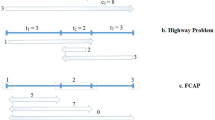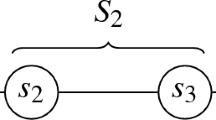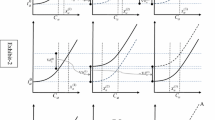Abstract
Ticket pricing in public transport usually takes a welfare maximization point of view. Such an approach, however, does not consider fairness in the sense that users of a shared infrastructure should pay for the costs that they generate. We propose an ansatz to determine fair ticket prices that combines concepts from cooperative game theory and linear and integer programming. The ticket pricing problem is considered to be a constrained cost allocation game, which is a generalization of cost allocation games that allows to deal with constraints on output prices and on the formation of coalitions. An application to pricing railway tickets for the intercity network of the Netherlands is presented. The results demonstrate that the fairness of prices can be improved substantially in this way.






Similar content being viewed by others
Change history
14 December 2017
The authors wish to correct the acknowledgement in page 68 from The work of Nam-Dũng Hoàng is funded by Vietnam National Foundation for Science and Technology Development (NAFOSTED).
Notes
In Hoang (2010) those coalitions are called essential. However this name exists already in cooperative game theory. We therefore use another name to avoid confusion.
References
Borndörfer, R., & Hoang, N.-D. (2012). Determining fair ticket prices in public transport by solving a cost allocation problem. In H. G. Bock, X. P. Hoang, R. Rannacher, & J. P. Schlöder (Eds.), Modeling, simulation and optimization of complex processes (pp. 53–63). Berlin: Springer.
Borndörfer, R., Neumann, M., & Pfetsch, M. E. (2006). Optimal fares for public transport. In: Operations Research Proceedings 2005, pp. 591–596.
Borndörfer, R., Neumann, M., & Pfetsch, M. E. (2008). Models for fare planning in public transport, Technical Report, ZIB Report 08–16, Zuse-Institut Berlin.
Bussieck, M. R. (1998). Optimal lines in public rail transport, Ph.D. thesis. TU Braunschweig.
Danna, E., Rothberg, E., & Le Pape, C. (2005). Exploring relaxation induced neighborhoods to improve MIP solutions. Mathematical Programming Series A, 102, 71–90.
Engevall, S., Göthe-Lundgren, M., & Värbrand, P. (1998). The traveling salesman game: An application of cost allocation in a gas and oil company. Annals of Operations Research, 82, 453–471.
Faigle, U., Kern, W., & Paulusma, D. (2000). Note on the computational complexity of least core concepts for min-cost spanning tree games. Mathematical Methods of Operations Research, 52, 23–38.
Gately, D. (1974). Sharing the gains from regional cooperation: A game theoretic application to planning investment in electric power. International Economic Review, 15, 195–208.
Hallefjord, Å., Helming, R., & Jørnsten, K. (1995). Computing the nucleolus when the characteristic function is given implicitly: A constraint generation approach. International Journal of Game Theory, 24, 357–372.
Hoang, N. D. (2010). Algorithmic cost allocation game: Theory and applications, Ph.D. thesis. TU Berlin.
Littlechild, S., & Thompson, G. (1977). Aircraft landing fees: A game theory approach. Bell Journal of Economics, 8, 186–204.
Maschler, M., Potters, J., & Tijs, S. (1992). The general nucleolus and the reduced game property. International Journal of Game Theory, 21, 85–106.
Straffin, P., & Heaney, J. (1981). Game theory and the tennessee valley authority. International Journal of Game Theory, 10, 35–43.
Young, H. P. (1994). Cost allocation. In R. J. Aumann & S. Hart (Eds.), Handbook of Game Theory (Vol. 2). Amsterdam: North-Holland.
Young, H. P., Okada, N., & Hashimoto, T. (1982). Cost allocation in water resources development. Water Resources Research, 18, 463–475.
Acknowledgments
We would like to thank three anonymous reviewers for their insightful comments on the paper. The work of Nam-Dũng Hoàng is funded by Vietnam National Foundation for Science and Technology Development (NAFOSTED).
Author information
Authors and Affiliations
Corresponding author
Additional information
A preliminary version of this paper appeared in the Proceedings of HPSC 2009 (Borndörfer and Hoang 2012). This journal article introduces better model and algorithms.
A correction to this article is available online at https://doi.org/10.1007/s10479-017-2731-9.
Rights and permissions
About this article
Cite this article
Borndörfer, R., Hoang, ND. Fair ticket pricing in public transport as a constrained cost allocation game. Ann Oper Res 226, 51–68 (2015). https://doi.org/10.1007/s10479-014-1698-z
Published:
Issue Date:
DOI: https://doi.org/10.1007/s10479-014-1698-z




